Samaaro + Your CRM: Zero Integration Fee for Annual Sign-Ups Until 30 June, 2025
- 00Days
- 00Hrs
- 00Min
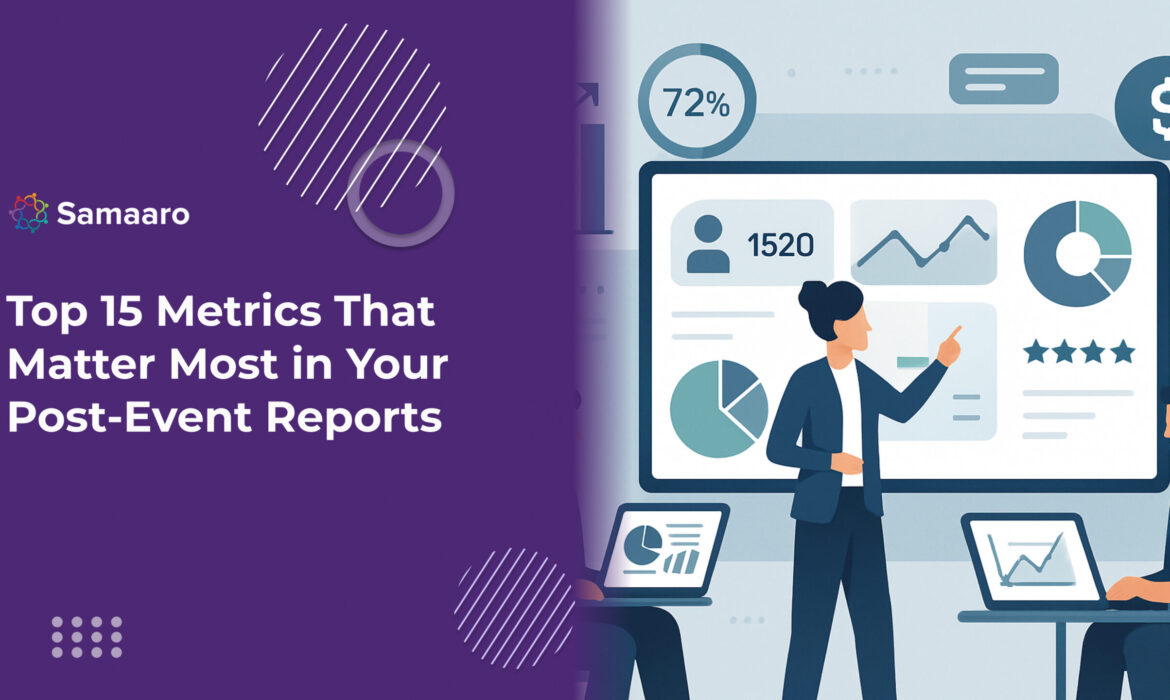
After several months of organizing, marketing, and executing, the event has ended. The booths are taken down, the lights are off, and the audience is gone. For many teams, this is when the reporting starts, exporting registration lists, counting survey responses, taking screenshots of social media impressions.
But therein lies the issue: too much data, too little insight.
Executives do not want a 40-slide deck of vanity metrics like, “1,000 likes on LinkedIn” or “3,000 emails sent.” They want an answer to a different question: “Did this event have business impact?”
This is where choosing the right metrics is important because event teams should be looking at 15 metrics that cheat to move the dial, representing quantitative, qualitative and strategic measures capturing a holistic story.
This blog highlights the top 15 post-event metrics every organization should identify and follow in their reports. Think of this as your measure: if you report on only these, you will be able to measure audience reach, engagement, satisfaction, ROI and longer-term impact on the business.
Let’s start here. Attendance, and reach metrics provide a degree of confidence that the promotional efforts were used effectively to attract the right audience, and how much top of funnel interest the event generated.
The number of individuals registered for the event. While it appears to be a basic metric, it does add context for the effectiveness of your promotions. Did your email marketing, ads and organic marketing get enough interest? Registrations provide that first answer.
How many of the registrants showed up? A strong attendance rate indicates your audience engaged in a value-added experience, whereas a low attendance rate could imply a problem with timing, relevance, or the registration-to-attendance process.
Every marketer has seen it: large registration numbers, but dismal turnout. Monitoring no-shows shows whether you are really getting the right people or just inflating lists with unqualified leads. It also acts as a compass for future improvements related to reminders, incentives, or scheduling.
All three metrics work together. They provide an anchor – did we grab attention and convert interest to attendance?
Once people show up, the next question is, “did they engage?” Passive attendance is no longer sufficient, especially when it comes to enterprise events; interaction shows a greater level of interest.
What sessions had the largest audiences? Tracking attendance by session helps capture hot topics, strong speakers, and content themes that resonate.
Polls administered in real-time or interactive surveys will show not only attendance, but engagement. Lots of poll responses suggest a high level of energy and buy-in; low poll responses may be an indicator of disengagement or poorly timed interaction.
How many questions were asked in the sessions? Did they scratch the surface or were they deep and detailed? Q&A activity is usually a proxy for relevance. If attendees are leaning forward, asking questions, and demanding further clarity, you likely hit the mark.
The three metrics working together show: Were attendees leaning in or just sitting back?
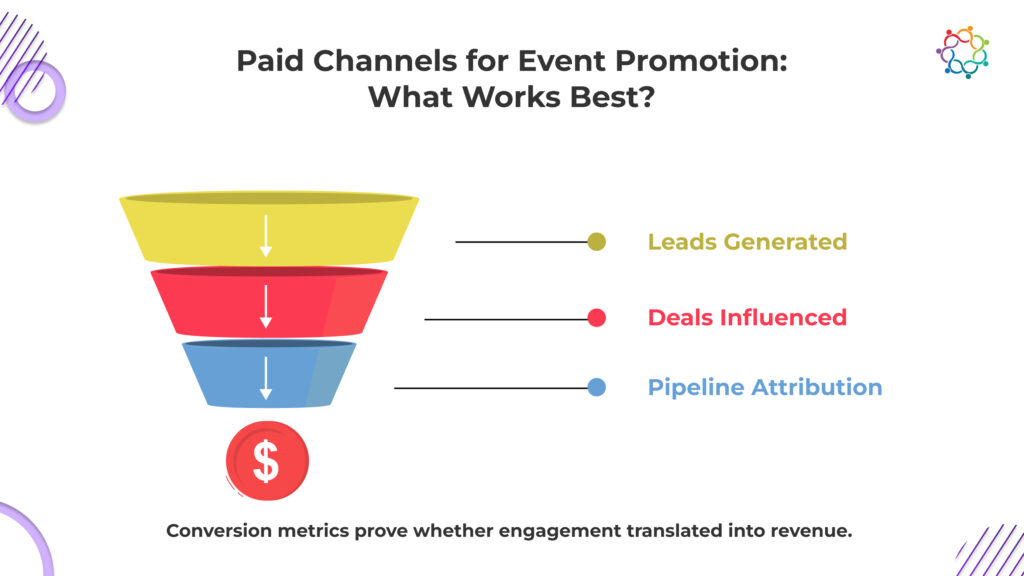
Here we change the conversation from participation to business outcomes. For companies, conversion metrics are the strongest evidence that events are not simply cost losses for branding, they are truly growth engines.
Aside from registrations, how many qualified leads did your event create? This includes booth scans, networking matches, and gated content downloads. The magic word here is qualified, raw contacts are not leads.
Now, going a level deeper: Which deals already in your CRM were influenced by the event? Did attendees attend sessions, meet with sales teams, or meet sponsors? Influenced deals show how your event contributed to the pipeline.
Possibly the most boardroom-friendly metric: What’s the monetary value of the opportunities that were linked directly to your event? We typically call this the pipeline attribution matrix, and this is the one that we can tie directly back to revenue.
With these three-conversion metrics, you’re answering the most important question that the CEO will want to know: “How did the event contribute to the company’s revenue growth?”
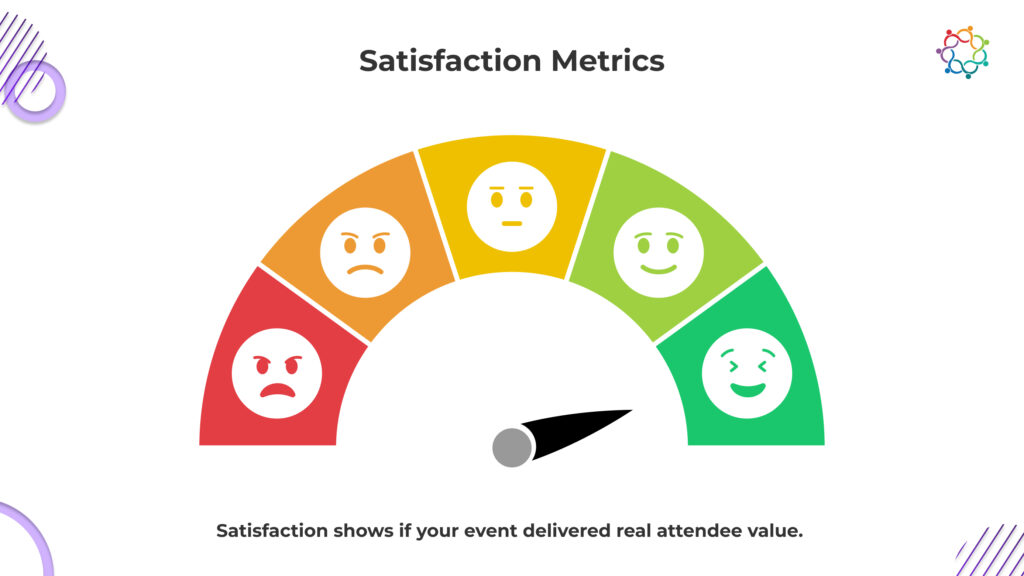
Events are not just numbers. Events are experiences. And satisfaction metrics show whether all those experiences cumulatively made attendees feel they got what they came for.
This common benchmark asks, “On a scale of 0-10, how likely are you to recommend this event?” It’s a simple and powerful question, a proxy for loyalty, and includes satisfaction overall.
CSAT digs a little further into the specifics. Asking the question, “How satisfied were you with the event overall?” is a direct measure of whether the attendee is happy with your event.
Ask your attendees to account for their feedback by different areas: logistics, speakers, networking, and content relevance. This will uncover some specific strengths and weaknesses, giving you the opportunity to improve in a data-driven way.
All these metrics are valuable, for attendance, ask a question like “Was the event meaningful and worth it?”
For many organizations content is the value driver whether through thought leadership, product buy-in, education, or industry positioning. If you measure & understand your content’s performance, you can extend the life of the event.
You can see how individual speakers performed, who inspired attendees and who tanked. This is crucial for giving you tools for planning future agendas.
The live event is important, yet it also might be the on-demand views that provide some long-tail lift. When you have robust on-demand replay metrics, they tell a story of huge value for the ticket price (basically because they got you views) and they mean your event is providing an on-going value.
Likes, shares, hashtag mentions and reposts provide information about how far your content travelled outside the event. They highlight a potential for amplification but should NOT be considered the measure of success.
These three have a follow-up: “Which themes of content-based engagement will remain?”
These are at the heart of enterprise conversations. While some of these metrics may come from the conversion portion of this post showing them explicitly clarifies things for the finance conversations.
These are numbers in addition to financial numbers; they are the numbers that build credibility. Human Resources, Customer Experience, and Engagement Representatives know how credibility feels in short supply. Demonstrating clear ROI from an event lets your executives see an event is a strategic investment, not just a cost centre.
While data will tell a story, we still crave context, which is why all post event reports do a decent job of also providing qualitative insights in addition to numbers.
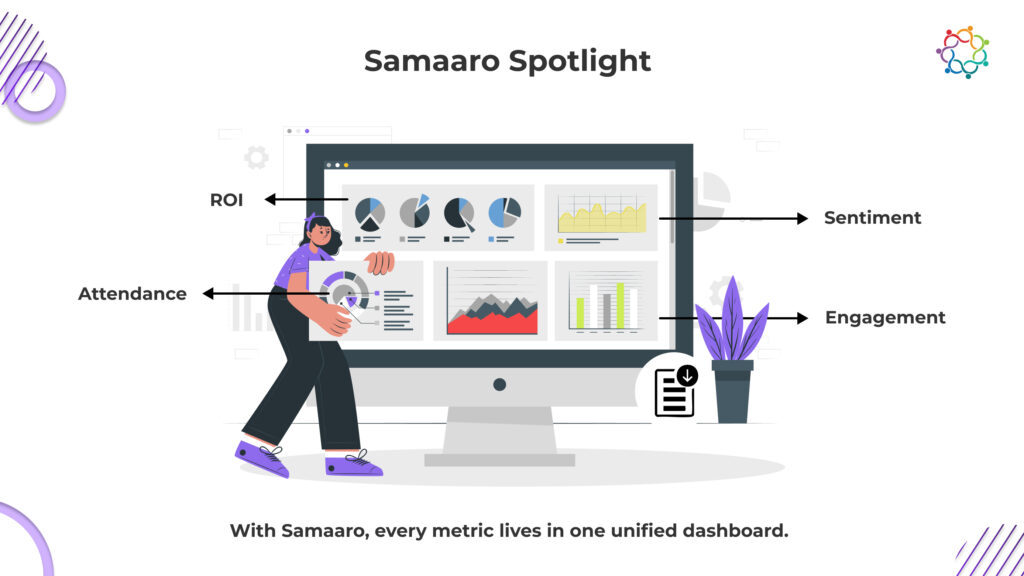
Most enterprise teams are problematic in that data are often Siloed, and Siloed engagement will not create a proper report because metrics could be whole disparate datasets. In this example, attendance could come from one platform, surveys from another, pipeline from a CRM, social analytics from yet another.
Samaaro has cracked the code with a full-service reporting suite that pulls your data all in one place, and is enterprise ready:
Samaaro provides you with a solution to automate reporting so that it is not an administrative exercise, but a task to tell the story of impact.
Given today’s circumstances of having more data than at any other point in human history, it is important to focus on the unique, distinct set of metrics features and improvements, to provide clarity. By bilocating to the 15 post event metrics, enterprise teams could produce a report that:
The best event teams understand that the report is not just about the numbers, but also about the narratives and stories it tells. When the correct metrics are selected intentionally and delivered strategically, it enables them to measure success while influencing the next answer to success.
Have a desire to streamline KPI tracking? Download our white paper on Post-Event Evaluation for more, or check-up Samaaro’s reporting process.

Built for modern marketing teams, Samaaro’s AI-powered event-tech platform helps you run events more efficiently, reduce manual work, engage attendees, capture qualified leads and gain real-time visibility into your events’ performance.
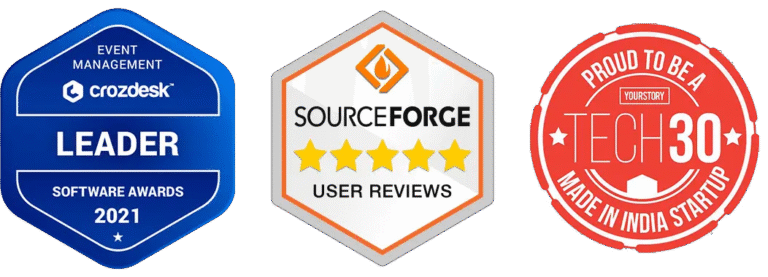
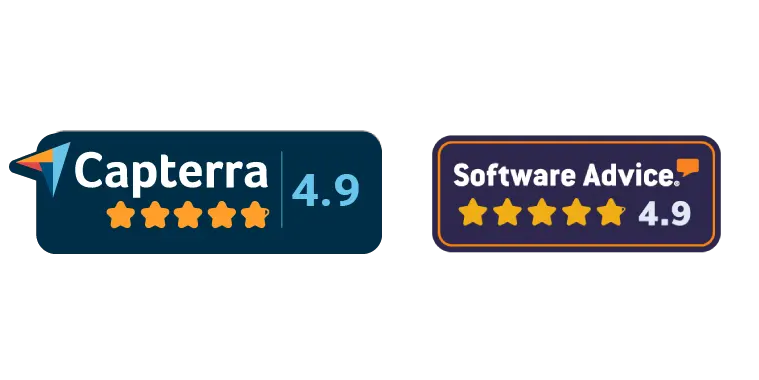
© 2025 — Samaaro. All Rights Reserved.